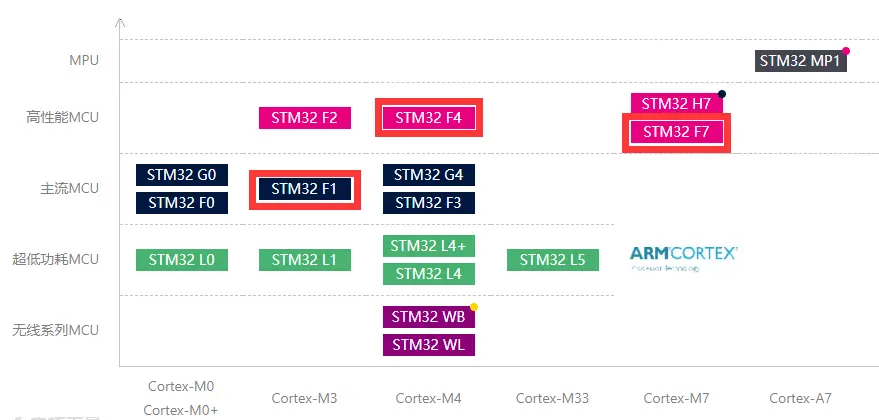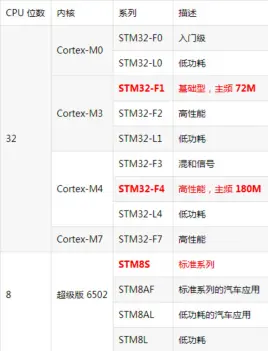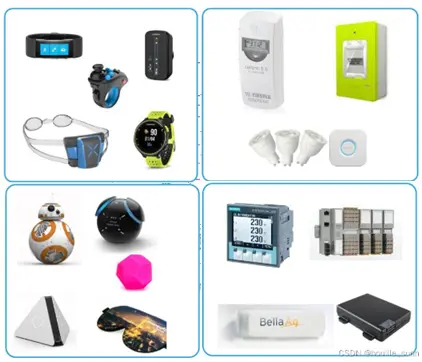STM32 development board--Which STM32 to choose
● STM32 Development Board Introduction
The STM32 development board is a circuit board that uses STM32 series microcontrollers to realize various module functions. STM32 development boards are currently very commonly used single-chip microcomputers. It uses ARM Cortex-M as the core and has the characteristics of high performance, low cost, low power consumption, and tailoring.
There are many types of STM32 development board. According to the core, they can be divided into four categories: Cortex-M0/-M0+, Cortex-M3, Cortex-M4 and Cortex-M7. According to the application of the development board, they can be roughly divided into ultra-low power consumption and mainstream. Type, high-performance type, for the types of STM32 development board knowledge we introduced in detail in the article "best STM32 development board for beginners", you can click this article to view. Among them, the most widely used are the three series of mainstream STM32F1, STM32F4 and STM32F7. To know how to choose an STM32 development board and which STM32 to choose, we need to understand and compare these three STM32 development boards series.


● STM32 Development Board Comparison
● STM32 development board F1 series:
Connected products (STM32F105/107)
Cortex-M3 72MHz, up to 64K bytes of SRAM, up to 256K bytes of Flash, USB2.0OTG full speed, 3-phase motor timer, 2 CAN2.0B, 2 I2S, Ethernet IEEE 1588v1
Enhanced product (STM32F103)
Cortex-M3 72MHz, up to 96K bytes of SRAM, up to 1M bytes of Flash, USB2.0 full-speed device, 3-phase motor timer, CAN2.0B, SDIO2 I2S
USB basic products (STM32F102)
Cortex-M3 48MHz, up to 16K bytes SRAM, up to 128K bytes Flash, USB2.0 full speed device
Basic product (STMF101)
Cortex-M3 36MHz, up to 80K bytes of SRAM, up to 1M bytes of Flash
Value-added products (STMF100)
Cortex-M3 24MHz, up to 32K bytes of SRAM, up to 512K bytes of Flash, 3-phase motor timer, CEC
● STM32 development board F4 series: high-performance products with DSP function (STM32F405/415/407/417)
Cortex-M4 168MHz DSP+FPU, up to 192K bytes of SRAM, up to 1M bytes of Flash, 2 USB 2.0OTG full speed/high speed, 3-phase motor timer, 2 CAN2.0B, SDIO 2 I2S camera interfaces, Ethernet IEEE 1588v2, Crypto/Hash Processor Random Number Generator
● STM32 Development Board Comparison Summary
1. Core differences
STM32 development board F1 series is Cortex-M3 core;
STM32 development board F4 series is Cortex-M4 core;
STM32 development board F7 series is the Cortex-M7 core.
2. Performance difference
Due to the differences in the cores, there are of course differences in the performance of the three STM32 development board kitseries.
Performance: F7>F4>F1, but in fact the performance of F7 is much stronger than that of F4, and the performance of F4 is slightly better than that of F1.
3. Difference in power consumption
Since there are differences in the performance of the three STM32 development boards products, the power consumption is naturally also different. Power consumption: F7>F4>F1, the better the performance, the greater the power consumption, which is very reasonable.
4. Specific manifestations of differences
(1) Main frequency: F7>F4>F1
(2) Peripherals: F7>F4>F1
(3) Core:
M3: Features of the M3 core
M4: Features of M3 core + DSP (Digital Signal Processing) instructions + support for floating-point operations
M7: Features of M4 core + double precision floating point operation + cache (cache) + TCM
● Which STM32 to choose
For any series STM32 development board, the knowledge of most common peripherals is the same, such as GPIO, serial port, timer, SPI, I2C, ADC, etc., so the STM32 series development boards can use the bottom board or the sensor module connected to the above-mentioned interface for testing.
● For beginners and enthusiasts, it is recommended to use the F103 series development board (STM32F103RCT6 development board, STM32F103VET6 Development Board, STM32F103ZET6 development board, F407 series development board (STM32F407ZGT6 development board, STM32F407IGT development board , STM32F407MP157 development board can be used for getting started. Among them, the F407 series STM32 development board kit has more functions than the F103 series STM32 development board, such as onboard STM32 with WIFI, STM32 with Ethernet, audio, STM32 with can communication interface, 232 communication interface, 485 communication interface, TF card, STM32 with Bluetooth interface, etc.
● For improvers, teachers, and trainers, it is recommended to use F7 series STM32 development boards, such as STM32F767IGT6 development boards, F7 series development boards are fully functional , strong performance.
In addition to the above products, the STM32 development boards series also has special STM32 for motor control series products and LINUX series development boards. STM32 for motor control, such as STM32F103IGT6 development board, STM32F103VET6 development board, STM32F103IIT6 development board. STM32 LINUX series development boards include i.MX 6ULL-Pro development board, i.MX 6ULL-mini development board etc. You can contact us for more information.
● STM32 Development Board Projects
The STM32 development boards can be used to develop a lot of product items, such as electronic products that can be seen in daily life, such as smart bracelets, micro quadcopters, balance cars, sweepers, mobile POST machines, smart rice cookers, 3D printers, robots etc., all have the credit of the STM32 development board kit.

● Contact us
There are also many STM32 development board manufacturer, if you want to buy STM32 development board buy online, you can buy STM32 development board from many way such as STM32 development board Aliexpress and STM32 development board amazon. There are many types of STM32 development board, and the learning materials are very rich and it is hard to say which one is the best STM32 development board. But if you don't choose a correct development board that suits you, it may have a negative effect on your study and affect your entry into this industry. As a professional STM32 development board manufacturer, we can provide you with professional development board selection suggestions, as well as corresponding STM32 development board schematic, STM32 development board tutorial, examples and other complete learning materials. Of course, if you are interested in STM32 development board programming and hope to use it to develop more products, please contact us too.
● Why STM32 is so popular?
1. STM32 development board series products are rich in variety.
STM32 is a 32-bit flash microcontroller based on the ARM Cortex M processor core. ARM is at the core of the development of digital electronic products; the STM32 development boards series are designed for embedded applications that require high performance, low cost, and low power consumption Designed ARM Cortex-M0, M0+, M3, M4 and M7 cores. Products include STM32F0, STM32F1, STM32F3), ultra-low power products (STM32L0, STM32L1, STM32L4, STM32L4+), high-performance products (STM32F2, STM32F4, STM32F7, STM32H7), etc. Complete models and wide selection.
2. STM32 development board information is open source, documents are rich;
3. The STM32 development board kit has stable performance, good reliability and high security.
STM32 is a low-power, high-performance microcontroller. In terms of low power consumption, it can run on a 2V power supply. When all devices are turned on at the same time and run at the full speed of 72MHZ, it only consumes 36mA of current. In the low power mode with the Cortex-M3 core After combination, only 2uA current consumption. In terms of protection, STM32 can lock its internal Flash so that crackers cannot read its content through the debug port. When the read protection function of Flash is enabled, its write protection function is also enabled. The write protection function is often used to prevent some unknown codes from being written into the interrupt vector table. Write protection can not only protect the interrupt vector table, but also extend its protection scope to the unused area in the whole Flash.
4. The STM32 development board price is reasonable (except for the price increase caused by the shortage of chips due to the impact of the epidemic last year).
5. Perfect library, no need to configure STM32F103C8T6 GPIO registers, shorten the development cycle.
6. STM32 series chips are used as the core controller.
It has high performance and low power consumption, rich peripheral interfaces, supports multiple expansions, and has the characteristics of flexible network application environment, so it is favored.
● Why STM32 is better than Arduino?
● Nature comparison:
Arduino is an open source electronic development prototyping platform. It includes hardware development boards, software IDEs and various development ecosystems. So Arduino is a combination of hardware and software.
The STM32 is based on the ARM Cortex-M series of microcontrollers. We use STM32 single-chip microcomputer to make a hardware development board, coupled with the commonly used Keil integrated development environment, also forms a complex of software and hardware.
● Performance comparison:
The Arduino development board uses an 8-bit single-chip microcomputer, which consumes a lot of power and the chip heats up significantly. STM32 adopts 32-bit single-chip microcomputer, low power consumption, low working environment temperature, no obvious heat generation. So STM32 far exceeds Arduino in terms of performance.
● Function comparison:
Most functions of Arduino have ready-made libraries, so it is very simple to use, but it is less controllable for slightly more complex functions.
For computing or control requirements, STM32 is a better choice. If you buy an STM32 development board, you must learn from the bottom layer of the hardware and master its various details.
STM32 development boards are more widely used, such as temperature controllers, ordinary motor controllers, low-end PLCs, and some civilian toys, game controllers, wired keyboards and mice and other peripherals, card-swiping POS machines in college cafeterias, etc. Much more practical.
Cost comparison:
For products with the same function, the cost of Arduino is higher than that of STM32.




